Thoroughly analyzing TS Inter 1st Year Maths 1A Model Papers and TS Inter 1st Year Maths 1A Question Paper March 2020 helps students identify their strengths and weaknesses.
TS Inter 1st Year Maths 1A Question Paper March 2020
Time: 3 Hours
Maximum Marks: 75
Note: This question paper consists of three sections A, B, and C.
Section – A
(10 × 2 = 20 Marks)
I. Very Short Answer Type Questions.
- Answer ALL questions.
- Each question carries TWO marks.
Question 1.
If f: R → R is defined by f(x) = \(\frac{1-x^2}{1+x^2}\), then show that f(tan θ) = cos 2θ.
Solution:
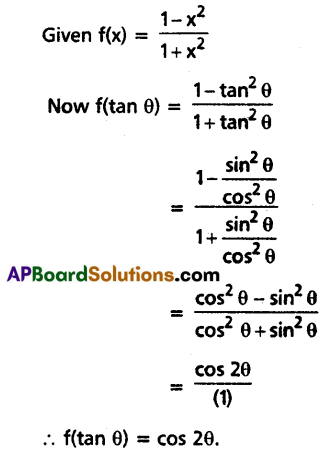
Question 2.
Find the domain of the real valued function f(x) = \(\frac{1}{\left(x^2-1\right)(x+3)}\).
Solution:
f(x) = \(\frac{1}{\left(x^2-1\right)(x+3)}\) ∈ R
⇔ (x2 – 1) (x + 3) ≠ 0
⇔ (x + 1) (x – 1) (x + 3) ≠ 0
⇔ x ≠ -1, 1, -3
∴ Domain of f is R – {-1, 1, -3}
![]()
Question 3.
If \(\left[\begin{array}{ccc}
x-1 & 2 & 5-y \\
0 & z-1 & 7 \\
-1 & 0 & a-5
\end{array}\right]=\left[\begin{array}{lll}
1 & 2 & 3 \\
0 & 4 & 7 \\
1 & 0 & 0
\end{array}\right]\), then find the values of x, y, z and a.
Solution:
Given \(\left[\begin{array}{ccc}
x-1 & 2 & 5-y \\
0 & z-1 & 7 \\
-1 & 0 & a-5
\end{array}\right]=\left[\begin{array}{lll}
1 & 2 & 3 \\
0 & 4 & 7 \\
1 & 0 & 0
\end{array}\right]\)
∴ x – 1 = 1 ⇒ x = 1 + 1 = 2
∴ 5 – y = 3 ⇒ y = 5 – 3 = 2
∴ z – 1 = 4 ⇒ z = 4 + 1 = 5
∴ a – 5 = 0 ⇒ a = 5
Question 4.
Define the Rank of a matrix.
Solution:
Let A be a non-zero matrix, the rank of A is defined as the maximum of the orders of the non-singular square submatrices of A. The rank of a null matrix is zero. The rank of a matrix A is denoted as rank(A) of p(A).
Question 5.
If the vectors \(-3 \overline{\mathrm{i}}+4 \overline{\mathrm{j}}+\lambda \overline{\mathrm{k}}\) and \(\mu \overline{\mathrm{i}}+8 \overline{\mathrm{j}}+6 \overline{\mathrm{k}}\) are collinear vectors, then find λ and µ.
Solution:
If the vectors \(a_1 \bar{i}+b_1 \bar{j}+c_1 \bar{k}\) and \(a_2 \bar{i}+b_2 \bar{j}+c_2 \bar{k}\) are collinear then \(\frac{a_1}{a_2}=\frac{b_1}{b_2}=\frac{c_1}{c_2}\)
⇒ \(\frac{-3}{\mu}=\frac{4}{8}=\frac{\lambda}{6}\)
⇒ \(\frac{-3}{\mu}=\frac{1}{2}\) ⇒ µ = -6
and \(\frac{\lambda}{6}=\frac{1}{2}\) ⇒ λ = 3
∴ λ = 3 and µ = -6
Question 6.
Find the vector equation of the plane passing through the points (0, 0, 0), (0, 5, 0) and (2, 0, 1).
Solution:
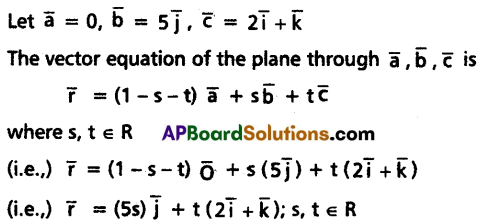
Question 7.
Find-the angle between the planes \(\bar{r} \cdot(2 \bar{i}-\bar{j}+2 \bar{k})=3\) and \(\bar{r} \cdot(3 \bar{r}+6 \bar{j}+\bar{k})=4\).
Solution:

Question 8.
Find a cosine function whose period is 7.
Solution:
\(\frac{2 \pi}{|k|}\) = 7
⇒ \(\frac{2 \pi}{7}\) = |k|
∴ cos kx = cos \(\frac{2 \pi}{7}\)x
Question 9.
What is the value of tan 20° + tan 40° + √3 tan 20° tan 40°?
Solution:
consider 20° + 40° = 60°
⇒ tan (20° + 40°) = tan 60°
⇒ \(\frac{\tan 20^{\circ}+\tan 40^{\circ}}{1-\tan 20^{\circ} \tan 40^{\circ}}\) = √3
⇒ tan 20° + tan 40° = √3 – √3 tan 20° tan 40°
⇒ tan 20° + tan 40° + √3 tan 20° tan 40° = √3
![]()
Question 10.
For any x ∈ R, prove that cosh4x – sinh4x = cosh(2x).
Solution:
L.H.S = cosh4x – sinh4x
= (cosh2x)2 – (sinh2x)2
= [cosh2x – sinh2x] [cosh2x + sinh2x]
= (1) cosh (2x)
= cosh (2x)
∴ cosh4x – sinh4x = cosh (2x)
Section – B
(5 × 4 = 20 Marks)
II. Short Answer Type Questions.
- Answer ANY FIVE questions.
- Each question carries FOUR marks.
Question 11.
If A = \(\left[\begin{array}{lll}
3 & 0 & 0 \\
0 & 3 & 0 \\
0 & 0 & 3
\end{array}\right]\), then find A4.
Solution:
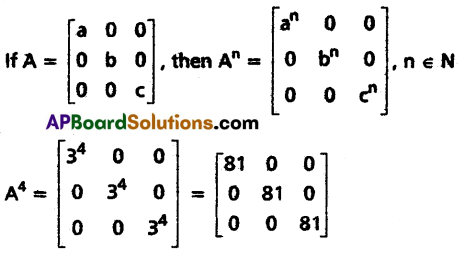
Question 12.
If the points whose position vectors are \(3 \overline{\mathrm{i}}-2 \overline{\mathrm{j}}-\overline{\mathrm{k}}, 2 \overline{\mathrm{i}}+3 \overline{\mathrm{j}}-4 \overline{\mathrm{k}}\), \(-\bar{i}+\bar{j}+2 \bar{k}\) and \(4 \bar{i}+5 \bar{j}+\lambda \bar{k}\) are coplanar, then show that λ = \(\frac{-146}{17}\).
Solution:
Let ‘O’ be the origin and Let A, B, C, and D be the given points. Then

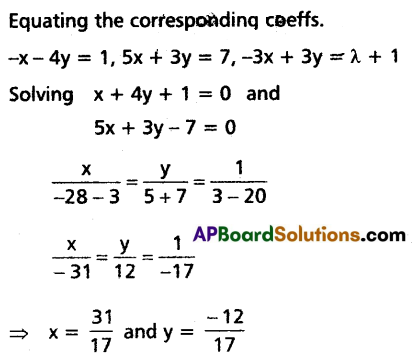

Question 13.
If |\(\bar{a}\)| = 13, |\(\bar{b}\)| = 5 and \(\overrightarrow{\mathrm{a}} \cdot \overline{\mathrm{b}}\) = 60, then find \(|\overline{\mathrm{a}} \times \overline{\mathrm{b}}|\).
Solution:
We have \(|\bar{a} \times \bar{b}|^2=|\bar{a}|^2|\bar{b}|^2-(\bar{a} \cdot \bar{b})^2\)
= (13)2 (5)2 – (60)2
= 169 × 25 – 3600
= 4225 – 3600
= 625
∴ \(|\bar{a} \times \bar{b}|=\sqrt{625}\) = 25
Question 14.
Prove that \(\cos \frac{2 \pi}{7} \cos \frac{4 \pi}{7} \cos \frac{8 \pi}{7}=\frac{1}{8}\).
Solution:
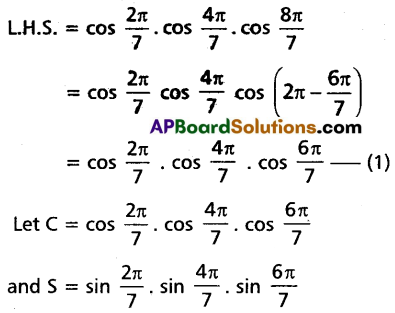
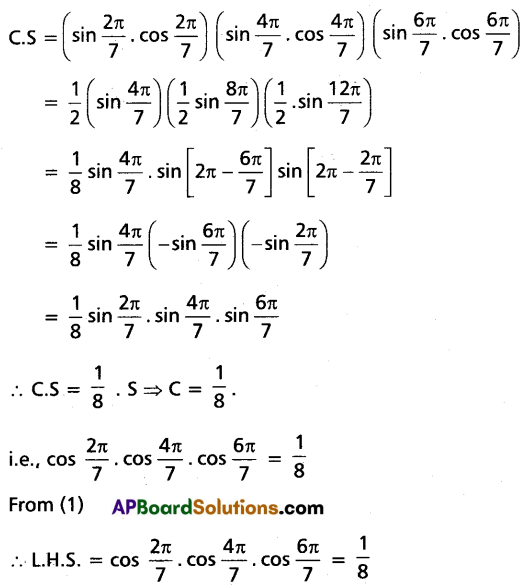
Question 15.
Solve the equation √3 sin θ – cos θ = √2.
Solution:
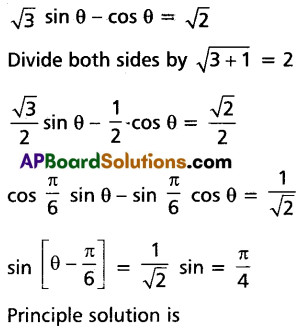
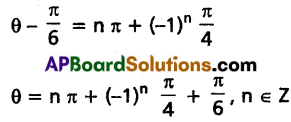
Question 16.
Prove that \(\sin ^{-1} \frac{4}{5}+2 \tan ^{-1} \frac{1}{3}=\frac{\pi}{2}\).
Solution:
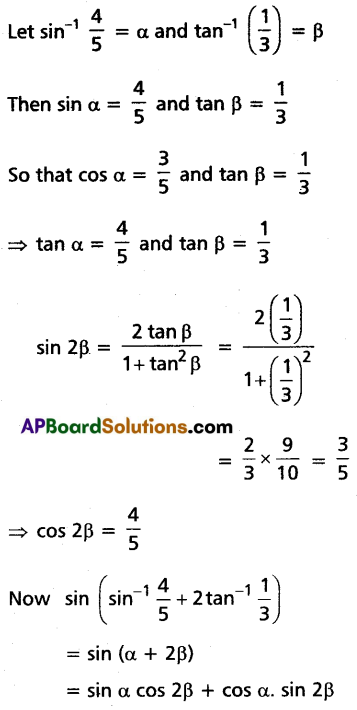

![]()
Question 17.
In ΔABC, show that \(b \cos ^2 \frac{C}{2}+c \cos ^2 \frac{B}{2}\) = s.
Solution:
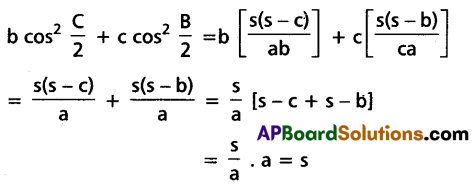
Section – C
(5 × 7 = 35 Marks)
III. Long Answer Type Questions.
- Answer ANY FIVE questions.
- Each question carries SEVEN marks.
Question 18.
If f: A → B, g: B → C are bijections, then show that (g o f)-1 = f-1 o g-1.
Solution:
f: A → B, g: B → C are bijections
⇒ gof: A → C is a bijection
Also g-1: C → B and f-1: B → A are bijections
⇒ f-1 o g-1: C → A is a bijection.
Let c be any element of C.
Then ∃ an element b ∈ B such that g(b) = c
⇒ b = g-1(c)
Also ∃ an element A such that f(a) = b
⇒ a = f-1(b)
Now (g o f) (a) = g(f(a)
= g(b)
= c
⇒ a = (g o f)-1 (c)
⇒ (g o f)-1 (c) = a
Also (f-1 o g-1) (c) = f-1 (g-1 (c))
= f-1 (b)
= a
From (1) and (2),
(g o f)-1 (c) = (f-1 o g-1 ( c))
⇒ (g o f)-1 = f-1 o g-1
Question 19.
Using mathematical induction, prove the statement:
a + ar + ar2 + ……..upto n terms = \(\frac{a\left(r^n-1\right)}{(r-1)}\), r ≠ 1.
Solution:
Let p(n) be the statement:
a + ar + ar2 + …….. + a . rn-1 = \(\frac{a\left(r^n-1\right)}{(r-1)}\), r ≠ 1
and let S(n) be the sum on the L.H.S
Since S(1) = a = \(\frac{a\left(r^1-1\right)}{r-1}\) = a
∴ p(1) is true
Assume that the statement is true for n = k
(i.e) S(k) = a + ar + ar2 + …….. + a . rk-1 = \(\frac{a\left(r^k-1\right)}{(r-1)}\)
We show that the statement is true for n = k + 1
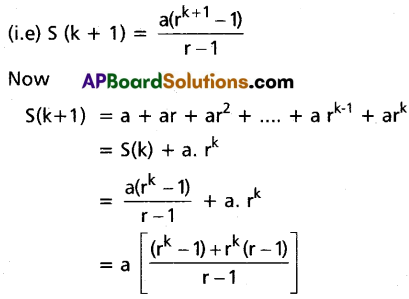

∴ The statement holds for n = k + 1
∴ By the principle of mathematical induction, p(n) is true for all n ∈ N.
∴ a + ar + ar2 + …….. + a . rn-1 = \(\frac{a\left(r^n-1\right)}{(r-1)}\), r ≠ 1
Question 20.
If \(\left|\begin{array}{lll}
a & a^2 & 1+a^3 \\
\text { b } & b^2 & 1+b^3 \\
c & c^2 & 1+c^3
\end{array}\right|\) = 0 and \(\left|\begin{array}{lll}
a & a^2 & 1 \\
b & b^2 & 1 \\
c & c^2 & 1
\end{array}\right|\) ≠ 0, then show that abc = -1.
Solution:
Hint: If each element in a row (column) of a square matrix is the sum of two numbers, then its discriminant can be expressed as the sum of discriminants of two square matrices.

= (1 + abc) \(\left|\begin{array}{lll}
1 & a & a^2 \\
1 & b & b^2 \\
1 & c & c^2
\end{array}\right|\) = 0
∴ 1 + abc = 0
⇒ abc = -1
![]()
Question 21.
Solve the system of equations x + y + z = 1, 2x + 2y + 3z = 6, x + 4y + 9z = 3 by using Cramer’s rule.
Solution:
Cramer’s rule:
Δ = \(\left|\begin{array}{lll}
1 & 1 & 1 \\
2 & 2 & 3 \\
1 & 4 & 9
\end{array}\right|\)
= 1(18 – 12) – 1(18 – 3) + 1(8 – 2)
= 6 – 15 + 6
= -3
Δ1 = \(\left|\begin{array}{lll}
1 & 1 & 1 \\
6 & 2 & 3 \\
3 & 4 & 9
\end{array}\right|\)
= 1(18 – 12) – 1(54 – 9) + 1(24 – 6)
= 6 – 45 + 18
= -21
Δ2 = \(\left|\begin{array}{lll}
1 & 1 & 1 \\
2 & 6 & 3 \\
1 & 3 & 9
\end{array}\right|\)
= 1(54 – 9) – 1(18 – 3) + 1(6 – 6)
= 45 – 15
= 30
Δ3 = \(\left|\begin{array}{lll}
1 & 1 & 1 \\
2 & 2 & 6 \\
1 & 4 & 3
\end{array}\right|\)
= 1(6 – 24) – 1(6 – 6) + 1(8 – 2)
= -18 – 0 + 6
= -12
x = \(\frac{\Delta_1}{\Delta}=\frac{-21}{-3}\) = 7
y = \(\frac{\Delta_2}{\Delta}=\frac{30}{-3}\) = -10
z = \(\frac{\Delta_3}{\Delta}=\frac{-12}{-3}\) = 4
∴ Solution is x = 7, y = -10, z = 4
Question 22.
Find the volume of the tetrahedron whose vertices are (1, 2, 1), (3, 2, 5), (2, -1, 0) and (-1, 0, 1).
Solution:
Let ‘O’ be the given A, B, C, D be the vertices of the ten tetrahedron. Then
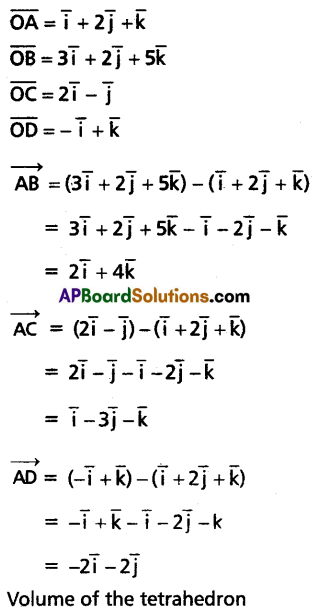
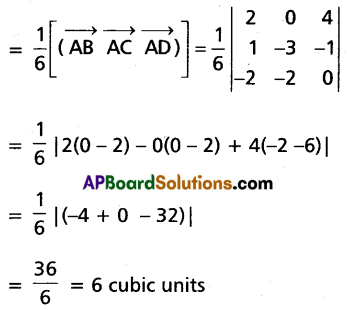
Question 23.
If A, B, C are angles in a triangle, then prove that sin A + sin B + sin C = \(4 \cos \frac{A}{2} \cos \frac{B}{2} \cos \frac{C}{2}\).
Solution:
∴ A, B, C are angles of a triangle
⇒ A + B + C = 180°
L.H.S = (sin A + sin B) + sin C
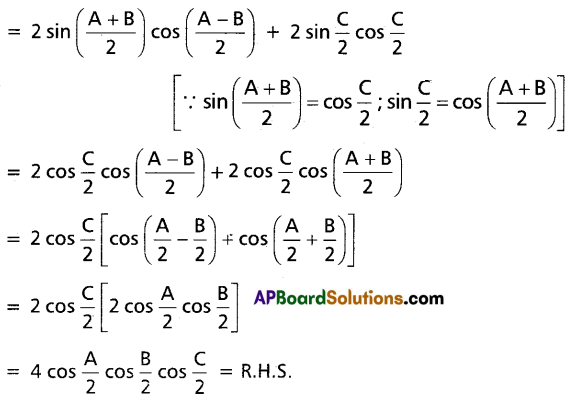
![]()
Question 24.
If r : R : r1 = 2 : 5 : 12, then prove that the triangle is right-angled at A.
Solution:
r : R : r1 = 2 : 5 : 12
then r = 2k, R = 5k and r1 = 12K
r1 – r = 12k – 2k = 10k = 2(5k) = 2R
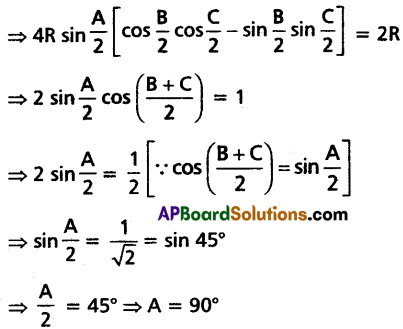
Hence, the triangle is right-angled at A.